Over the past ten years, the food delivery sector has become increasingly competitive, with many brands capturing a significant market share worldwide. It is due to people’s busy and fast-paced lives, and the recent COVID-19 pandemic has made online meal ordering even more popular.
BusinessWire reports that the food delivery market will hit US$1.02tn in 2023. It makes it a great time to build a food App. Companies like Zomato, Ubereats, Doordash, and Swiggy also introduce new trends to shape the industry.
In 2023, there will be many food delivery trends that will emerge. This blog explores why creating a food delivery app is a wise decision for restaurateurs and food entrepreneurs.
Let’s look at why this move is timely and essential for the modern dining experience.
The Growing Demand for Food Delivery Services: A Statistical Overview
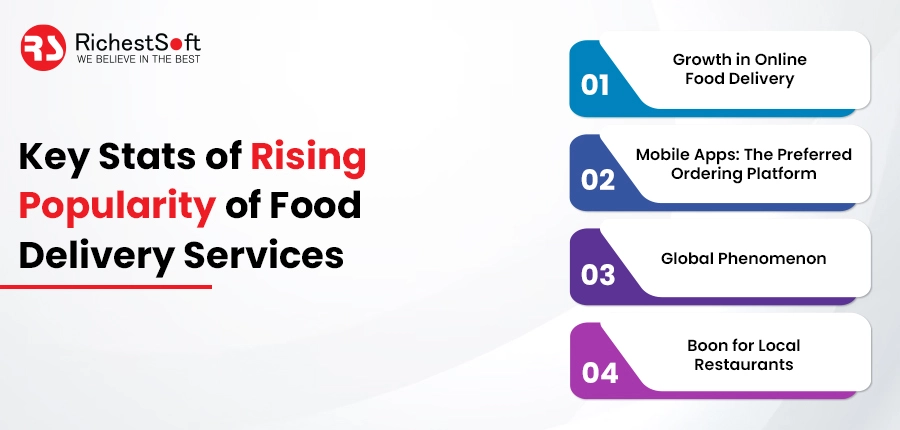
The food delivery industry is becoming increasingly widespread, which has altered how we eat. Let’s look at prime statistics and data to understand this trend further.
✅ Explosive Growth in Online Food Delivery
The online food delivery industry has undergone exponential growth. According to industry reports, it will reach over US$1.65tn by 2027. This meteoric rise indicates the increasing preference for the convenience and ease offered by food delivery services.
✅ Mobile Apps: The Preferred Ordering Platform
The prevalence of smartphones has played a pivotal role in the growth of food delivery services. A substantial portion of orders – approximately 79% – is now placed through mobile apps. This trend reflects the seamless user experience and accessibility provided by these platforms.
✅ Global Phenomenon
No one region has all of the demand for meal delivery services. It is a worldwide occurrence. Online food orders have increased significantly, from the United States to India and Europe to Asia. This widespread adoption underscores the universal appeal of convenient dining options.
✅ Boon for Local Restaurants
Food delivery platforms have not only benefited consumers but have also provided a lifeline for local restaurants. These platforms offer smaller, independent eateries the opportunity to reach an extensive customer base without the need for extensive marketing efforts or significant infrastructure investments.
Benefits to Integrate Food Delivery App into a Business
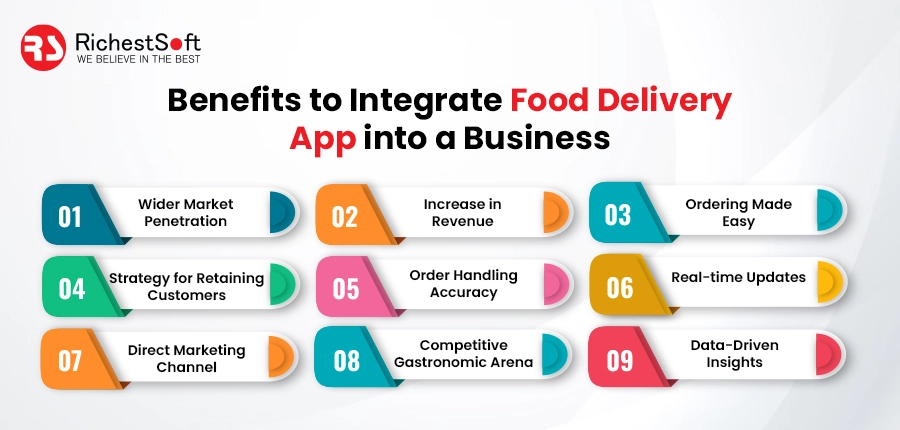
In the ever-evolving food industry, quickly adapting and providing convenience is crucial. Implementing a cutting-edge food delivery app is a convenient way to fulfill this. There are multiple benefits to utilizing this avant-garde technology, which we will examine in further detail.
✔️ Wider Market Penetration: Culinary Delights, Anytime, Anywhere
By introducing a food delivery app, you transcend the boundaries of your physical location. Your delectable offerings can now reach an expansive customer base far beyond the confines of your brick-and-mortar establishment.
✔️ Increase in Revenue: Huge Potential
Unleashing the power of delivery services can boost revenue streams. With the app channeling a steady flow of orders, your financial gains are balanced for an impressive upswing.
✔️ Ordering Made Easy: Where Convenience Meets Culinary Craft
The food app offers a seamless and hassle-free ordering process for customers. With a few taps on their smartphones, they can effortlessly navigate your menu and place their orders, enhancing their overall dining experience.
✔️ Strategy for Retaining Customers: A Recipe for Customer Retention
You’re sowing the seeds of customer loyalty by ensuring a consistently reliable and punctual delivery service. Satisfied customers are more likely to return, becoming steadfast patrons of your culinary venture.
✔️ Order Handling Accuracy: Reducing Error Margin
A food delivery app streamlines the order-taking process, minimizing the chances of miscommunication or errors. It ensures that each order is meticulously processed and dispatched, upholding the integrity of your service.
✔️ Real-time Updates: A Window into the Journey of Culinary Delights
Customers cherish real-time updates on the status of their orders. With the food app, they can track the progress of their delivery, forging a connection of trust and transparency between your business and its valued patrons.
✔️ Direct Marketing Channel: Taking Advantage of Success with Strategic Promotions
The app provides a direct line of communication with your customer base. This avenue allows you to roll out enticing promotions, special offers, and updates, keeping your clientele engaged and invested in your culinary offerings.
✔️ Supremacy in a Competitive Gastronomic Arena: Setting Your Culinary Venture Apart
In a fiercely competitive market, offering delivery through an app can be your distinguishing edge. It showcases your commitment to meeting the evolving needs of modern consumers, placing you ahead of establishments relying solely on conventional dine-in services.
✔️ Data-Driven Insights: Discovering Hidden Culinary Gems
A food delivery app serves as a treasure trove of valuable data. It offers insights into customer preferences, ordering patterns, and popular menu items. This reservoir of information empowers you to make informed decisions tailored to meet the discerning tastes of your clientele.
Adapting to the Post-Pandemic Landscape
The outbreak of the COVID-19 pandemic has significantly transformed the approach to different aspects of life, and dining is no exception. One of the most prominent changes is the rapid adoption of food delivery services. Let’s examine the causes behind this trend and explain.
👉 Pandemic Push
The pandemic forced restaurants, cafes, and eateries worldwide to reevaluate their business models. With dine-in services restricted or temporarily halted, the reliance on food delivery skyrocketed. Cautious about public spaces, consumers turned to the convenience and safety of having meals delivered to their doorsteps. This surge has been a lifeline for businesses and a transformative moment in the food industry.
👉 Tech-Forward Approach
The pandemic highlighted the importance of having a solid online presence, which hastened the shift towards online platforms. Companies with strong internet presence and effective distribution methods were better prepared to withstand the challenge. Others saw that adopting technology, such as creating user-friendly food delivery apps, was no longer a luxury but a need.
👉 Eco-Friendly Advantage
When optimized efficiently, food delivery apps can contribute to more sustainable practices. Businesses can minimize environmental impact by streamlining delivery routes and employing eco-friendly packaging. It aligns with the growing consumer consciousness towards sustainable and eco-friendly practices, providing an additional competitive edge.
👉 Meeting Consumer Expectations
Consumers today value technology and their time. They want things to be easy and fast, even when ordering and getting food. That’s why food delivery apps are so popular: they are designed to be simple and efficient, meeting these expectations quickly. Being prepared for a digitally-driven future means meeting these expectations head-on.
Trends and Innovations in Food Delivery Technology
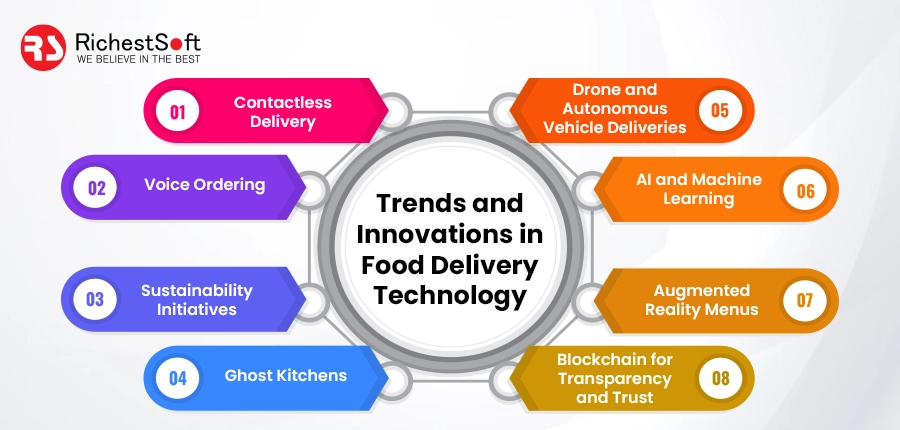
Food delivery is changing quickly because of new technology and what people want. Here are some things that are making a difference in food delivery.
✅ Contactless Delivery: Safety First
In response to the COVID-19 pandemic, contactless delivery has become the model. Customers now have the chance to have their food dropped off at their homes without physically interacting with the delivery man. This trend will stay a priority for consumers even in a post-pandemic world, as it gives safety & comfort.
✅ Voice Ordering: A Hands-Free Experience
With the advent of smart speakers and virtual assistants, voice ordering has gained popularity. Customers can now place food orders using voice commands, providing a convenient, hands-free experience.
✅ Sustainability Initiatives: Going Green
Consumers are increasingly conscious of the environmental impact of food delivery. As a result, platforms and restaurants are adopting eco-friendly practices. It includes using biodegradable packaging, optimizing delivery routes, and implementing recycling programs.
✅ Ghost Kitchens: The Rise of Delivery-Only Restaurants
Ghost kitchens, virtual or cloud kitchens, are designed solely for fulfilling online food orders. These kitchens eliminate the need for a physical dining space, allowing restaurants to focus exclusively on delivery. This trend is gaining traction, particularly in densely populated urban areas.
✅ Drone and Autonomous Vehicle Deliveries: The Future is in the Skies
Businesses are looking into using drones and autonomous vehicles to deliver meals. Despite being in its early stages, this technology has enormous potential for speeding up deliveries and extending the reach of food delivery services.
✅ AI and Machine Learning: Personalized Recommendations
Artificial intelligence and machine learning algorithms analyze customer data and preferences. It allows food delivery platforms to offer personalized recommendations, enhancing the user experience. From suggesting favorite dishes to predicting delivery times, AI is revolutionizing how customers interact with food delivery apps.
✅ Augmented Reality (AR) Menus: Visualizing Your Meal
AR technology is being integrated into food delivery apps to provide customers with interactive menus. Using smartphones, customers can view dishes in 3D, get detailed information, and even see how the food will appear on their table.
✅ Blockchain for Transparency and Trust
Blockchain technology is being utilized to enhance transparency in the food delivery supply chain. It allows consumers to trace the journey of their food from the source to their plate, ensuring authenticity and quality. This innovation is significant for those who prioritize knowing the origin of their meals.
Factors to Choose Food Delivery App Service for Your Business
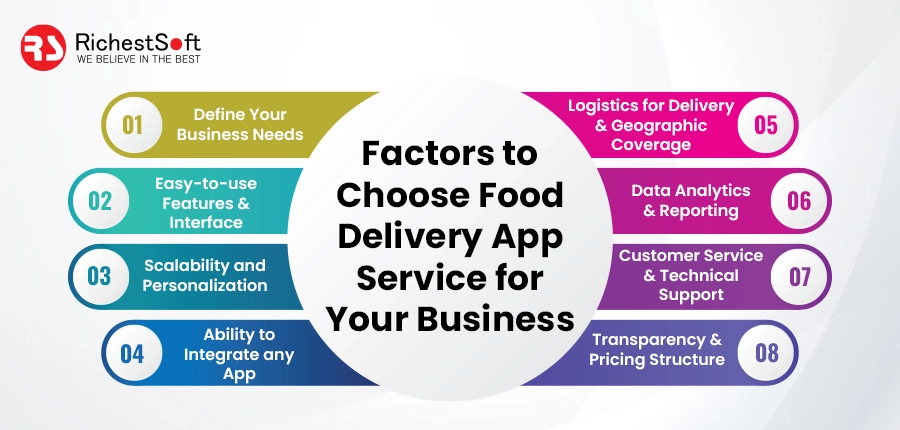
Are you operating a restaurant or a food business in today’s digital world? Then you know how important it is to build food app to feed your customers’ requirements. With numerous options, how can you determine the most suitable one? Let’s examine the prime factors for selecting a food delivery app service –
👉 Define Your Business Needs
The first step is to comprehend the particular requirements of your company. Are you a big restaurant franchise or an independent local eatery? Do you have a comprehensive menu or focus on one type of food? Comprehending your precise requirements will make it easier to select an alternative.
👉 Easy-to-use Features & Interface
An intuitive user interface is essential for both your workers and customers. Users should be able to easily explore menus, personalize orders, and make payments using the App’s simple user interface. To enhance the user experience, look for features like real-time order tracking and online payment with multiple options, reviews, and ratings.
👉 Scalability and Personalization
Your food delivery app should be customizable to reflect your brand identity. It includes adding your logo, color schemes, and menu items. Moreover, it should be scalable to accommodate future growth. As your business expands, the app should seamlessly adapt to your changing needs.
👉 Ability to Integrate any App
Consider the integration capabilities of the App with your existing systems. It should smoothly sync with your point-of-sale (POS) system, inventory management, and payment processing tools. It provides smooth operations and decreases the likelihood of errors.
👉 Logistics for Delivery & Geographic Coverage
Evaluate the App’s capabilities in terms of delivery logistics. It should allow you to define delivery zones, set delivery fees, and manage delivery times.
Additionally, check if the app provider covers the geographical areas you serve. It ensures that your customers receive their orders promptly and efficiently.
👉 Data Analytics & Reporting
Access to data analytics and reporting tools is invaluable for making informed business decisions. The App should provide insights into customer behavior, popular menu items, order volumes, and more. This information can guide your marketing efforts and menu optimization.
👉 Customer Service & Technical Support
Dedicated customer help is prime in case of any technical problems or questions. Ensure that the app provider offers accessible customer support channels and timely assistance. It includes options like email support, live chat, and phone support.
👉 Transparency & Pricing Structure
Examine the pricing structure of the app solution. It should be transparent, with understandable details on any setup fees, transaction fees, or subscription costs. Additionally, consider the return on investment (ROI) you can expect from the app in terms of increased sales and customer satisfaction.
Overcoming Challenges and Ensuring Success
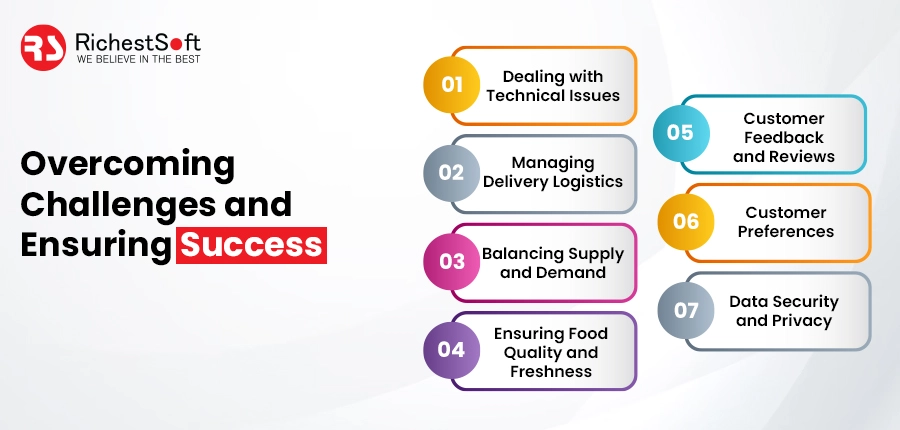
Integrating a food delivery app into your business is a strategic move but challenging. Let’s explore some common hurdles and practical strategies to ensure a smooth transition and ongoing success.
✔️ Dealing with Technical Issues
Technical issues can arise during the implementation of a food delivery app, from glitches to server downtimes.
Solution
Choose a reputable app development provider with a track record of successful implementations. Additionally, ensure they offer robust technical support for troubleshooting and quickly resolving any issues.
✔️ Managing Delivery Logistics
Managing delivery logistics can be complex, including route planning, tracking, and ensuring timely deliveries.
Solution
Invest in a delivery management system that integrates seamlessly with your app. It will help optimize routes, provide real-time tracking, and allow for efficient dispatching of orders.
✔️ Balancing Supply and Demand
Striking a balance between the volume of orders and your kitchen’s capacity can take time and effort, especially during peak hours.
Solution
Implement features like order throttling or queue management within your app. These tools can help regulate the flow of orders and prevent overwhelm in the kitchen.
✔️ Ensuring Food Quality and Freshness
Maintaining the quality and freshness of food during delivery can be a concern for both businesses and customers.
Solution
Invest in quality packaging that preserves the integrity of the food. Consider using insulated containers or specialized packaging for different types of dishes. Additionally, prioritize proximity-based delivery to ensure shorter travel times.
✔️ Handling Customer Feedback and Reviews
Negative feedback or reviews can impact your business’s reputation. It’s important to address them quickly & professionally.
Solution
Establish a process for handling customer feedback. Respond promptly, acknowledge any issues, and offer solutions or compensations where appropriate. Use feedback as an option for advancement.
✔️ Adapting to Changing Customer Preferences
Customer preferences and trends can evolve. Staying relevant and meeting new demands is essential.
Solution
Regularly update your menu offerings based on customer feedback and industry trends—leverage data from your app to identify popular items and introduce new dishes or promotions.
✔️ Ensuring Data Security and Privacy
With sensitive customer information handled through the app, data security is paramount.
Solution
Execute strong security standards, including encryption protocols & secure payment gateways. Regularly update your app to patch any possible security vulnerabilities.
FAQs
How to initiate your own food delivery business in 2023?
- Market Research: Understand your target audience, local competition, and their preferences.
- Business Plan: Draft your business model, budget, marketing strategy, and working processes.
- Legal Considerations: Register your business, get necessary licenses, and comply with health & safety laws.
- Choose a Niche: Decide if you’ll focus on a specific cuisine, dietary requirements, or a unique selling proposition.
- Build Your Team: Hire delivery drivers, kitchen staff, and customer service representatives.
- Develop a Website or App: Either hire a development team or use a food delivery platform.
- Partner with Restaurants: Establish collaborations with local restaurants to deliver various menus.
- Marketing and Promotion: Utilize digital marketing, social media, and promotions to reach potential customers.
- Delivery Logistics: Execute smooth delivery systems & consider options like in-house delivery or third-party services.
How do I build an app for my food business?
- Define Requirements: Decide on features like menu display, order placement, payment processing, and delivery tracking.
- Choose a Development Approach: Decide between custom development or a food delivery platform.
- Hire a Development Team: If going custom, hire developers, designers, and QA testers.
- Design UI/UX: Create an intuitive and user-friendly interface for customers and drivers.
- Integrate Payment and Delivery Systems: Set up secure payment gateways and implement a reliable delivery management system.
- Development & Testing: Code and thoroughly test the App for functionality, security, and performance.
- Launch & Marketing: Deploy the App on relevant app stores and promote it through various channels.
- Continuous Updates: Regularly update the App to add new features, improve performance, and address any issues.
Is a food delivery app suitable for my type of business?
A food delivery app is a beneficial resource for diverse food businesses, including cafes, bakeries, restaurants, and specialty food stores. Food delivery apps facilitate these establishments to grow their customer base and improve their overall revenue by reaching more potential customers.
Is a food delivery app profitable?
Yes, a well-managed food delivery app can be profitable. Factors that contribute to profitability include:
- A large customer base.
- Effective marketing strategies.
- Efficient operations.
- A competitive commission structure for partnering restaurants.
However, profitability may differ based on market competition, delivery fees, and operational costs.
How can I make an app like DoorDash & Zomato?
To build an app like DoorDash or Zomato, you need to do the following things:
- Market Research: Start by identifying your target audience, their preferences, and the competition in your area. Understanding your market is fundamental in catering to your customers effectively.
- Choose Features: Decide on the essential features your food app will offer. Consider menu browsing, order placement, payment processing, and real-time tracking options to enhance the user experience.
- Select a Development Approach: Determine whether you want to build your food app from scratch or utilize an existing food delivery platform like DoorDash or Zomato. The choice depends on your particular requirements and resources.
- Design the App: Design an eye-catching user interface (UI) and a seamless user experience (UX) for customers & delivery drivers. User-friendly design is vital to attracting and retaining users.
- Development and Testing: Develop the App and subject it to strict testing. It guarantees the app functions perfectly, is secure, and performs well under various conditions.
- Integrate Payment and Delivery Systems: Implement secure payment gateways and a reliable delivery management system to facilitate seamless transactions and efficient order processing.
- Launch: Once your App is ready, launch it on app stores and start marketing it. Utilize digital marketing, social media, and partnerships to reach potential customers and promote your app effectively.
How do food apps make money?
Food delivery apps typically make money through the following revenue streams:
1. Commission Fees: Restaurants pay a percentage of each order’s total as a commission for using the platform.
2. Delivery Fees: Customers may be charged a fee for the delivery service.
3. Subscription Services: Offer premium features or subscriptions for restaurants or customers.
4. Advertising and Promotions: Restaurants can pay for featured listings or promotions on the app.
5. Partnerships and Collaborations: Collaborate with restaurants for special offers or exclusive deals.
Conclusion
The meal delivery industry is growing, with many people ordering lunch online. It presents an excellent opportunity for you to build food app based on these trends. However, it’s essential to carefully analyze all the things before investing, as some require significant capital to get started.
To guarantee the success of your meal delivery product, it’s essential to partner with a dedicated on-demand food delivery app development company. At RichestSoft, we have a team of professionals with over a decade of experience creating scalable, secure, and user-friendly apps. We can build an app in just 7 weeks. Don’t just take our word for it – check out our work portfolio and testimonials from happy clients.
 +1 315 210 4488
+1 315 210 4488 +91 798 618 8377
+91 798 618 8377


